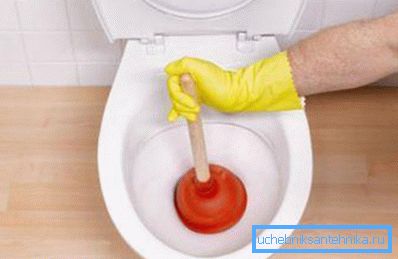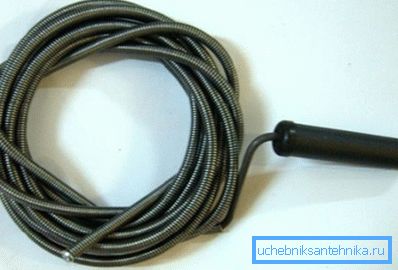Sewage blockage: what to do!
Perhaps all the housewives and their husbands ever needed to remove the clogging of the sewer, but this very often turns out to be not so simple, and some have to resort to the traditional call of a plumber. In order to prevent this from happening, you need to follow the rules of operation of sanitary facilities, as well as understand the causes that lead to blockages, and, of course, acquire basic cleaning skills yourself.
Below we look at this topic in more detail, and also show you the video in this article.

Blockages and their elimination
Note. In this article we will pay attention mainly to the blockage in the sewage system in the apartment or in a private house, that is, to what you can fix yourself.
The reasons

- We all understand that the prevention of the disease is better than its subsequent treatment - in the same way in the case of sewage pipes - it is better not to allow contamination than to solve this problem.. As you, probably, paid attention, practically each instruction to siphons does not recommend to wash away solid garbage, and sometimes the sizes of particles are even regulated.
- But in this case, you can not even look at the numbers, but to focus on the size of the siphon net - everything that does not fit into the cell should be collected and thrown into the trash can, but not shoved there and not thrown into the toilet.! For sinks and shower stalls (boxes) in such cases, they even put an additional, smaller, mesh so that large particles and hair are collected in it, after which the contents are sent to solid waste.

- Also, to prevent serious blockages, you should use chemical, alkaline or acidic agents, which can be in the form of powder, granules, gel or liquid, especially since their price is low. It is necessary to use such preparations when you see that the drain has become worse - this means that fat has accumulated on the walls of pipes and / or siphons, which prevents the drain.
Cleaning in practice

The simplest clearing of sewage blockages is done with the help of a plunger, which simply pushes the accumulated debris with air pressure, as if breaking a lump in parts, which allows the water to carry it into a pipe of a larger section, where it will pass unhindered. This method can be used for any household plumbing point, such as a sink, washbasin, shower stall (bath), bathroom, toilet and even a dishwasher.

In addition, the cause of the blockage can be a siphon under the sink or sink, it can be seen that there is a sink everywhere, except for a certain point taken separately (most often it is a kitchen sink). In such cases, you need to remove the siphon from the bowl, as shown in the photo above, and not just clean it, but wash it with running water.
Cork in such cases is usually caused by small debris that sticks to oily walls and most of it is in the sump (preliminary preventive maintenance by chemical means practically excludes the occurrence of such situations).
But more serious blockages occur not in siphons, but in the drainage system itself in corner joints, that is, in those places where the pipe turns, and such clusters are collected not only in 90-degree adapters, but with smooth bends of the knees. And the following happens - at the junction, in any case, a seam remains and for such a seemingly insignificant unevenness several hairs can catch on which the fat begins to accumulate and the more this accumulation, the faster it increases in size.
This can also occur if textile fibers are injected into the drain, where fat waste is very well retained.

In such cases, the plunger is practically powerless, although sometimes it also works, but here the use of plastic or metal plumbing cable is more suitable. Currently, sewage pipes made of metal are very rare, therefore, the cable must be with a knob on the end where all the ends of the wire are collected (see also the article Sewer plug: purpose, principle of operation, types).
Since metal wire for cables is made of carbon steel, it is very elastic and protruding ends will scratch the insides not only of plastic, but also of metal pipe and the created grooves will serve as an excellent trap for oily waste.
To remove blockages in the sewage system, you first need to determine the area where sewage has accumulated; this is done by a simple method of elimination. For example, in an apartment, the last plumbing unit is usually a kitchen sink, followed by a bath or shower (box), a wash basin behind it, and the last or closest toilet to the riser (a bidet can be inserted before it).
If, for example, water comes off the sink and the toilet, it means that the blockage is between the bath and the sink, but if there are no problems in the bath too, it means that sewage has accumulated between the sink and the bath - this principle can be used to identify the problem area, as in an apartment and in the house.

After identifying the problem area, you need to clear the sewer pipe from the siphon pipe and, through a vertical (inclined) hole in the tee, start the cable, pointing it in the direction of the blockage. For such an operation, as a rule, you need two people - one rotates the handle at the end of the cable, and the other sends it to the sewer pipe.
Some people are wondering what to do - if the sewage system in a private house is clogged up, because there the sewer line can be much longer and the maximum cable length is 15m at most, but this means that it will not be enough for more than 5-7m - the size is hidden due to formed during the rotation of the spiral.
In large areas of the room, tees are slammed into the pipe, where the outlet is closed with a lid and serves as an audit, and there should be inspection wells outside (for long distances).

Note. If the sewer riser is clogged, it is cleaned in the same way as the pipes in the apartment (house) with the help of a plumbing cable through a revision that is necessarily installed on each floor. But if there is none, then it is done through the tee, to which the toilet is connected (the toilet for this time, of course, is disconnected).
Conclusion
If you follow the instructions given in this material, you can always eliminate the blockage in the sewage system yourself, and you will not have to call a plumber. In addition, it will be very good if the 10-meter cable, plunger and chemicals will always be at home.